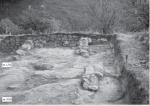Summary (English)
EXPLORATIONS NEAR THE VILLAGE OF SVALENIK (Deyan Dragoev – dragoev78@yahoo.com) Trenches K/20 and L/20 were explored in the southern part of the fortress. Two construction periods were documented. The first one dated to AD 325 – 400 when the fortification system was built. More than 4 m from the inner side of the southern fortification wall were discovered. The wall was built in opus incertum of roughly cut stones bonded with mortar and was preserved up to four – five courses in height. A coin of Constantius II, minted in AD 324 – 330 and discovered inside the eastern fortification wall, was a terminus post quem for the construction of the fortification. The second construction period dated to the end of the 5th – first quarter of the 7th centuries AD when a building adjoining the inner side of the southern fortification wall was constructed. The building was up to 8.40 m in width and 20 m of its length were explored so far. The foundations of the walls were built of roughly cut ashlars bonded with mud and the upper parts were constructed with sun-dried bricks. Interior walls, partitioning the building and constructed in rubble masonry, were discovered and two rooms were documented. The eastern room was 2.20 m wide. A layer of debris was explored over the floor, containing burned fragmentary sun-dried bricks and wall plaster. The finds included a terracotta lamp, sherds from amphorae, pots and lids, and a bronze fibula of the 6th century AD. A layer of debris was discovered in the western room, containing burned fragmentary sun-dried bricks and wall plaster. The finds included sherds from pots and amphorae of the end of the 6th – first quarter of the 7th centuries AD. The building was destroyed by a fire. Two occupation periods were documented in the building. After the earlier building was burned, a new building with reduced size was constructed over the remains. The bronze fibula of the 6th century AD, discovered in the layer beneath the floor of the later building, was a terminus post quem for the reconstruction and the second occupation period.
- Deyan Dragoev - Regional Museum of History – Ruse
Director
Team
Research Body
- Regional Museum of History – Ruse






![Download [PDF]](/excavation/skins/fasti/images/results/download_sml.png)